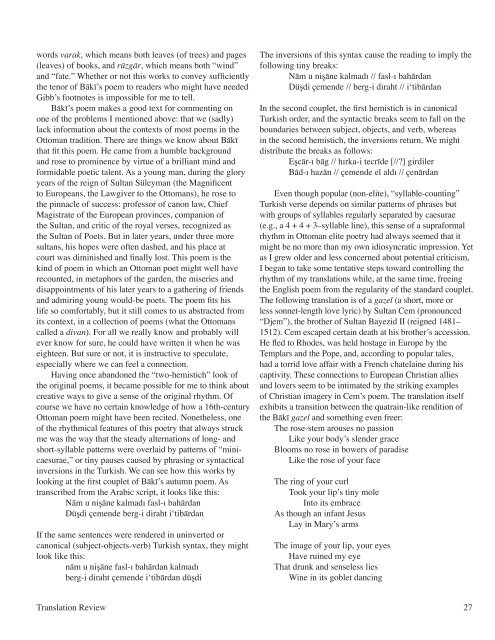Translation Review - The University of Texas at Dallas
Translation Review - The University of Texas at Dallas
Translation Review - The University of Texas at Dallas
You also want an ePaper? Increase the reach of your titles
YUMPU automatically turns print PDFs into web optimized ePapers that Google loves.
words varak, which means both leaves (<strong>of</strong> trees) and pages<br />
(leaves) <strong>of</strong> books, and rūzgār, which means both “wind”<br />
and “f<strong>at</strong>e.” Whether or not this works to convey suffi ciently<br />
the tenor <strong>of</strong> Bākīʼs poem to readers who might have needed<br />
Gibbʼs footnotes is impossible for me to tell.<br />
Bākīʼs poem makes a good text for commenting on<br />
one <strong>of</strong> the problems I mentioned above: th<strong>at</strong> we (sadly)<br />
lack inform<strong>at</strong>ion about the contexts <strong>of</strong> most poems in the<br />
Ottoman tradition. <strong>The</strong>re are things we know about Bākī<br />
th<strong>at</strong> fi t this poem. He came from a humble background<br />
and rose to prominence by virtue <strong>of</strong> a brilliant mind and<br />
formidable poetic talent. As a young man, during the glory<br />
years <strong>of</strong> the reign <strong>of</strong> Sultan Süleyman (the Magnifi cent<br />
to Europeans, the Lawgiver to the Ottomans), he rose to<br />
the pinnacle <strong>of</strong> success: pr<strong>of</strong>essor <strong>of</strong> canon law, Chief<br />
Magistr<strong>at</strong>e <strong>of</strong> the European provinces, companion <strong>of</strong><br />
the Sultan, and critic <strong>of</strong> the royal verses, recognized as<br />
the Sultan <strong>of</strong> Poets. But in l<strong>at</strong>er years, under three more<br />
sultans, his hopes were <strong>of</strong>ten dashed, and his place <strong>at</strong><br />
court was diminished and fi nally lost. This poem is the<br />
kind <strong>of</strong> poem in which an Ottoman poet might well have<br />
recounted, in metaphors <strong>of</strong> the garden, the miseries and<br />
disappointments <strong>of</strong> his l<strong>at</strong>er years to a g<strong>at</strong>hering <strong>of</strong> friends<br />
and admiring young would-be poets. <strong>The</strong> poem fi ts his<br />
life so comfortably, but it still comes to us abstracted from<br />
its context, in a collection <strong>of</strong> poems (wh<strong>at</strong> the Ottomans<br />
called a divan). For all we really know and probably will<br />
ever know for sure, he could have written it when he was<br />
eighteen. But sure or not, it is instructive to specul<strong>at</strong>e,<br />
especially where we can feel a connection.<br />
Having once abandoned the “two-hemistich” look <strong>of</strong><br />
the original poems, it became possible for me to think about<br />
cre<strong>at</strong>ive ways to give a sense <strong>of</strong> the original rhythm. Of<br />
course we have no certain knowledge <strong>of</strong> how a 16th-century<br />
Ottoman poem might have been recited. Nonetheless, one<br />
<strong>of</strong> the rhythmical fe<strong>at</strong>ures <strong>of</strong> this poetry th<strong>at</strong> always struck<br />
me was the way th<strong>at</strong> the steady altern<strong>at</strong>ions <strong>of</strong> long- and<br />
short-syllable p<strong>at</strong>terns were overlaid by p<strong>at</strong>terns <strong>of</strong> “minicaesurae,”<br />
or tiny pauses caused by phrasing or syntactical<br />
inversions in the Turkish. We can see how this works by<br />
looking <strong>at</strong> the fi rst couplet <strong>of</strong> Bākīʼs autumn poem. As<br />
transcribed from the Arabic script, it looks like this:<br />
Nām u nişāne kalmadı fasl-ı bahārdan<br />
Düşdi çemende berg-i diraht iʻtibārdan<br />
If the same sentences were rendered in uninverted or<br />
canonical (subject-objects-verb) Turkish syntax, they might<br />
look like this:<br />
nām u nişāne fasl-ı bahārdan kalmadı<br />
berg-i diraht çemende iʻtibārdan düşdi<br />
<strong>The</strong> inversions <strong>of</strong> this syntax cause the reading to imply the<br />
following tiny breaks:<br />
Nām u nişāne kalmadı // fasl-ı bahārdan<br />
Düşdi çemende // berg-i diraht // iʻtibārdan<br />
In the second couplet, the fi rst hemistich is in canonical<br />
Turkish order, and the syntactic breaks seem to fall on the<br />
boundaries between subject, objects, and verb, whereas<br />
in the second hemistich, the inversions return. We might<br />
distribute the breaks as follows:<br />
Eşcār-ı bāg // hırka-i tecrīde [//?] girdiler<br />
Bād-ı hazān // çemende el aldı // çenārdan<br />
Even though popular (non-elite), “syllable-counting”<br />
Turkish verse depends on similar p<strong>at</strong>terns <strong>of</strong> phrases but<br />
with groups <strong>of</strong> syllables regularly separ<strong>at</strong>ed by caesurae<br />
(e.g., a 4 + 4 + 3–syllable line), this sense <strong>of</strong> a supraformal<br />
rhythm in Ottoman elite poetry had always seemed th<strong>at</strong> it<br />
might be no more than my own idiosyncr<strong>at</strong>ic impression. Yet<br />
as I grew older and less concerned about potential criticism,<br />
I began to take some tent<strong>at</strong>ive steps toward controlling the<br />
rhythm <strong>of</strong> my transl<strong>at</strong>ions while, <strong>at</strong> the same time, freeing<br />
the English poem from the regularity <strong>of</strong> the standard couplet.<br />
<strong>The</strong> following transl<strong>at</strong>ion is <strong>of</strong> a gazel (a short, more or<br />
less sonnet-length love lyric) by Sultan Cem (pronounced<br />
“Djem”), the brother <strong>of</strong> Sultan Bayezid II (reigned 1481–<br />
1512). Cem escaped certain de<strong>at</strong>h <strong>at</strong> his brotherʼs accession.<br />
He fl ed to Rhodes, was held hostage in Europe by the<br />
Templars and the Pope, and, according to popular tales,<br />
had a torrid love affair with a French ch<strong>at</strong>elaine during his<br />
captivity. <strong>The</strong>se connections to European Christian allies<br />
and lovers seem to be intim<strong>at</strong>ed by the striking examples<br />
<strong>of</strong> Christian imagery in Cemʼs poem. <strong>The</strong> transl<strong>at</strong>ion itself<br />
exhibits a transition between the qu<strong>at</strong>rain-like rendition <strong>of</strong><br />
the Bākī gazel and something even freer:<br />
<strong>The</strong> rose-stem arouses no passion<br />
Like your bodyʼs slender grace<br />
Blooms no rose in bowers <strong>of</strong> paradise<br />
Like the rose <strong>of</strong> your face<br />
<strong>The</strong> ring <strong>of</strong> your curl<br />
Took your lipʼs tiny mole<br />
Into its embrace<br />
As though an infant Jesus<br />
Lay in Maryʼs arms<br />
<strong>The</strong> image <strong>of</strong> your lip, your eyes<br />
Have ruined my eye<br />
Th<strong>at</strong> drunk and senseless lies<br />
Wine in its goblet dancing<br />
<strong>Transl<strong>at</strong>ion</strong> <strong>Review</strong> 27

















